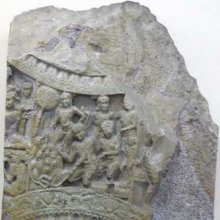Campeyya Jataka, Campeyya-jātaka: 2 definitions
Introduction:
Campeyya Jataka means something in Buddhism, Pali. If you want to know the exact meaning, history, etymology or English translation of this term then check out the descriptions on this page. Add your comment or reference to a book if you want to contribute to this summary article.
Images (photo gallery)
In Buddhism
Theravada (major branch of Buddhism)
Source: Pali Kanon: Pali Proper NamesOnce the king of Magadha, at constant war with the king of Anga, obtaining the help of the Naga king who dwelt in the river Campa, defeated his rival. Thereafter he held an annual festival in honour of the Naga king. The Bodhisatta, a very poor man, saw Campeyyas splendour on his way to the feast and longed for a like greatness. As a result, after death, he was born in the Naga world where he became king under the name of Campeyya. Realising what had happened, he felt disgust at his position as a Naga and made many attempts to observe religious vows, hoping, in this way, to gain release. But he was foiled in his efforts by his consort Sumana. At last he came to the world of men, where he kept fast on certain days, lying on an ant hill. There he was taken captive by a snake charmer who tortured him in various ways and took him about, exhibiting him for gain. By certain tokens of which Campeyya had earlier warned her, Sumana knew that her husband had been taken captive and, after much searching, she discovered him just as the snake charmer was about to give a performance before Uggasena, king of Benares. The whole story was then revealed, and the snake charmer set Campeyya free. That Uggasena might be convinced of the truth of the story, he was invited to the Naga world, where he and his retinue were lavishly entertained.
The story was related in connection with the observance of uposatha vows. Devadatta was the snake charmer and Sariputta was Uggasena. Rahulamata was Sumana (J.iv.454-68).
The Campeyya cariya is included in the Cariyapitaka (p.85f ) in order to illustrate silaparamita.
This Jataka is often referred to (E.g., J.i.45; MA.ii.617) as one of the births in which the Bodhisatta practised sila to perfection.
Theravāda is a major branch of Buddhism having the the Pali canon (tipitaka) as their canonical literature, which includes the vinaya-pitaka (monastic rules), the sutta-pitaka (Buddhist sermons) and the abhidhamma-pitaka (philosophy and psychology).
See also (Relevant definitions)
Partial matches: Campeyya, Jataka.
Full-text: Campeyya Cariya, Campeyya, Ugrasena, Campaka, Campa, Uggasena.
Relevant text
Search found 5 books and stories containing Campeyya Jataka, Campeyya-jātaka; (plurals include: Campeyya Jatakas, jātakas). You can also click to the full overview containing English textual excerpts. Below are direct links for the most relevant articles:
Amaravati Art in the Context of Andhra Archaeology (by Sreyashi Ray chowdhuri)
Campeyya Jātaka < [Chapter 3 - Amarāvatī and the Formative Stage of the Buddhist Art]
Amarāvatī impact on later schools of Indian art < [Chapter 5 - Impact of Amarāvatī Art]
The Great Chronicle of Buddhas (by Ven. Mingun Sayadaw)
(8) Eighth Pāramī: The Perfection of Resolution (adhiṭṭhāna-pāramī) < [Chapter 6 - On Pāramitā]
Taxila < [May 1939]
The Jataka tales [English], Volume 1-6 (by Robert Chalmers)
Jataka 506: Campeyya-jātaka < [Volume 4]
The Mahavastu (great story) (by J. J. Jones)
